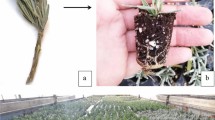Abstract
Thirty-seven bitter gourd genotypes belonging to Momordica charantia (30 accessions) and Momordica balsamina (5 accessions) species were evaluated against root knot nematode, Meloidogyne incognita under artificial conditions to identify the resistant source(s). Results demonstrated that all the five M. balsamina accessions (MB-3, MB-5, MB-6, MB-7 and Local-1) showed resistant reaction to root knot nematode in terms of low root galls, soil nematode population and reproduction factor. On the other hand, most of M. charantia accessions were found moderately susceptible or susceptible to root knot nematode except two lines (PAUBG-1 and PAUBG-13) which gave moderate resistant reaction. Further, cluster analysis was used to investigate the resistance among 37 bitter gourd genotypes based on their growth and resistance indexes after inoculation with M. incognita. The bitter gourd accessions/genotypes under the present study could be divided into five groups based upon their resistance levels viz., resistant, moderately resistant, moderately susceptible, and highly susceptible to M. incognita. All the M. balsamina accessions exhibited resistance while M. charantia accessions exhibited moderate resistant, susceptible and highly susceptible reaction to root knot nematode.


Similar content being viewed by others
References
Anwar SA, McKenry MV (2010) Incidence and reproduction of Meloidogyne incognita on vegetable crop genotypes, Pakistan. J Zool 42:135–141
Behera TK (2004) Heterosis in bitter gourd. In: Singh PK, Dasgupta SK, Thpathi SK (eds) Hybrid vegetable development. Haworth Press, New York, pp 217–221
Chandra P, Sao R, Gautam SK, Poddar AN (2010) Initial population density and its effect on the pathogenic potential and population growth of the root-knot nematode Meloidogyne incognita in four species of cucurbits. Asian J Plant Pathol 4:1–15
Cobb NA (1918) Estimating the nema population of soil, with special reference to the sugar-beet and root-gall nemas, Heterodera schachtii Schmidt and Heterodera radicicola (Greef) Müller, and with a description of Tylencholaimus aequalis n. sp. Govt. Print. Off., Washington
Jones JT, Haegeman A, Danchin EEJ, Perry RN (2013) Top 10 plant-parasitic nematodes in molecular plant pathology. Mol Plant Pathol 14:946–961
Joseph JK (2005) Studies on eco geography and genetic diversity of the genus Momordica L. in India. Dissertation, Mahatma Gandhi University, Kottayam, Kerala, India
Kaur S, Pathak M (2011) Sources of resistance in Varh karela (Momordica balsamina L.) to root knot nematode. Plant Dis Res 26:174
Krishnaveni M, Subramanian S (2005) Root knot nematodes of cucurbits and their management—a review. Agric Rev 26:103–113
Montalvo AE, Esnard J (1994) Reaction of ten cultivars of watermelon (Citrullus lanatus) to a Puerto Rican population of Meloidogyne incognita. J Nematol 26:640–643
Nei M (1972) Genetic distance between populations. Am Nat 106:283–292
Pitrat M, Chauvet M, Foury C (1999) Diversity, history and production of cultivated cucurbits. Acta Hortic 492:21–28
Pofu KM, Mashela PW (2013) Potential use of Momordica balsamina ethnomedicinal plant as alternative crop in soil with high population densities of Meloidogyne incognita race 2. Proc Afr Crop Sci Conf 11:355–360
Pofu KM, Mashela PW, Mphosi MS (2010) Responses of Cucumis africanus and Cucumis myriocarpus to Meloidogyne incognita race 2 under microplot conditions. Int J Nematol 20:113–118
Pofu KM, Mashela PW, Oelofse D (2015) Nematode resistance in bitter gourd to Meloidogyne incognita. Acta Agric Scand 65:1–5
Rohlf FJ (1998) NTSYSpc, version 2.02g. Exter Software. Applied Biosystematics Inc
Seinhorst JW (1967) The relationships between population increase and population density in plantparasitic nematodes II, sedentary nematodes. Nematologica 13:157–171
Singh SK, Conde B, Hodda M (2012) Root knot nematode (Meloidogyne incognita) on Bitter Melon (Momordica charantia) near Darwin, Australia. Aus Plant Dis Notes 7:75–78
Tamil Selvi NA, Pugalendhi L, Sivakumar M (2013) Screening of Cucurbitaceous rootstocks against root knot nematode Meloidogyne incognita Kofoid and White. Asian J Hortic 8:720–725
Taylor AL, Sasser JN (1978) Biology, identification and control of root-knot nematodes (Meloidogyne spp.). Department of Plant Pathology, North Carolina State University: United States Agency for International Development, Raleigh
Thomason IJ, McKinney HE (1959) Reaction of some cucurbitaceae to root knot nematodes (Meloidogyne spp.). Plant Dis Rep 43:448–450
Westerdahl BB, Becker JO (2011) UC IPM pest management guidelines: cucurbits. http://www.ipm.ucdavis.edu/PMG/r116200111.html. Accessed 22 Feb 2012
Author information
Authors and Affiliations
Corresponding author
Additional information
Publisher's Note
Springer Nature remains neutral with regard to jurisdictional claims in published maps and institutional affiliations.
Rights and permissions
About this article
Cite this article
Sharma, R., Kaur, S., Dhillon, N.K. et al. Identification of resistance in cultivated and wild bitter gourd against root knot nematode, Meloidogyne incognita. Indian Phytopathology 72, 203–208 (2019). https://doi.org/10.1007/s42360-019-00122-z
Received:
Revised:
Accepted:
Published:
Issue Date:
DOI: https://doi.org/10.1007/s42360-019-00122-z




